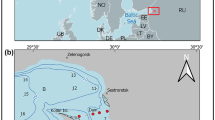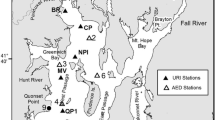Abstract
A year-long study of incident and underwater light transmittance (400–800 nm) in the Rhode River, Maryland, a tidal tributary to Chesapeake Bay, indicated that light transmittance responded in both intensity and spectral quality to changes in the amount and type of dissolved and suspended materials in the water. At times of relatively clear water, transmittance was similar to that previously reported in the literature for coastal waters. With high concentrations of suspended and dissolved materials in the water, attenuation of irradiance was high in the upper part of the water column and different for the various wave bands, depending on the type of material present. At such times, attenuation was higher in the upper part of the water column under sunny, clear skies than on cloudy days. We believe this to be due to higher concentrations of pigments and suspended particles in the water on sunny days, increasing the scattering and adsorption. A second factor was a lower average cosine on cloudy days, decreasing the effect of scattering on the average path length per meter of depth. High attenuation coefficients in the middle of the spectrum are attributed to accessory pigments. Regression of the diffuse attenuation coefficient on eight water-quality parameters explained up to 93% of the variance in the attenuation coefficient. Chlorophylls a and c and mineral suspensates were the three most important variables for data taken under clear skies. In contrast, under cloudy skies, the three most important variables were different for different wavelengths. Models of irradiance attenuation in turbid estuarine waters require the use of more variables than models for open ocean waters.
Similar content being viewed by others
Literature Cited
Bukata, R. P., J. H. Jerome, J. E. Bruton, S. C. Jain, and H. H. Zwick. 1981. Optical water quality model of Lake Ontario. 1: Determination of optical cross sections of organic and inorganic particulates in Lake Ontario. Appl. Optics 2:1696–1713.
Champ, M. A., G. A. Gold, W. E. Bozzo, S. G. Ackleson, and K. C. Vierra. 1980. Characterization of light extinctions and attenuation in Chesapeake Bay, August 1977, p. 263–277. In V. S. Kennedy (ed.), Estuarine Perspectives. Academic Press, New York.
Cory, R. L., and P. V. Dresler. 1980. Water quality in Rhode River at Smithsonian Institution Pier near Annapolis, Maryland, January 1976 through December 1978. U.S. Geological Survey Water-Resources Investigations 79–109. 53 p.
Duntley, S. Q. 1963. Light in the sea. Opt. Soc. Am. J. 53:214–233.
Egan, W. G., and T. W. Hilgeman. 1979. Optical Properties of Inhomogenous Materials. Academic Press, New York. 235 p.
Faust, M. A., J. C. Sager, and B. W. Meeson. 1982. Response of Prorocentrum mariae-lebouriae (Dinophyceae) to light of different spectral qualities and irradiances: Growth and pigmentation. J. Phycol. 18:49–356.
Goldberg, B., W. H. Klein, D. L. Correll, and J. W. Pierce. 1985. Instrumentation for performing spectral measurements in a marine environment. J. Mar. Technol. 18:#4, 6 p.
Jeffrey, S. W., and G. F. Humphrey. 1975. New spectrophotometric equation for determining chlorophyl a, b, c1, and c2 in higher plants, algae, and natural phytoplankton. Biochem. Physiol. Pflanz (BPP). 167:191–194.
Jerlov, N. G. 1976. Marine Optics. Elsevier, New York, 231 p.
Kiefer, D. A., and J. B. Soo Hoo. 1982. Spectral absorption by marine particles of coastal waters off Baja California. Limnol. Oceanogr. 17:492–499.
Kirk, J. T. O. 1979. Spectral distribution of photosynthetically active radiation in some southeastern Australian waters. Aust. J. Mar. Freshw. Res. 30:81–91.
Kirk, J. T. O. 1980. Spectral absorption properties of natural waters: Contribution of the soluble and particulate fractions to light absorption in some inland waters of southeastern Australia. Aust. J. Mar. Freshw. Res. 31:287–296.
Kirk, J. T. O. 1981. Monte Carlo study of the nature of the underwater light field in, and the relationship between optical properties of, turbid yellow waters. Aust. J. Mar. Freshw. Res. 32:517–532.
Kirk, J. T. O. 1984. Dependence of relationship between inherent and apparent optical properties of water on solar altitude. Limnol. Oceanogr. 29:350–356.
Macalaster, E. G., D. A. Barker, and M. W. Kasper. 1983. Chesapeake Bay: A Profile of Environmental Change. Environmental Protection Agency, Philadelphia, PA. 200 p.
National Research Council. 1983. Fundamental Research on Estuaries: The importance of an Interdisciplinary Approach. National Academy Press, Washington, DC. 79 p.
Prieur, L., and S. Sathyendranath. 1981. An optical classification of coastal and oceanic waters based on the specific spectral absorption curves of phytoplankton pigments, dissolved organic matter, and other particulate materials. Limnol. Oceanogr. 26: 671–689.
Shoaf, W. T., and B. W. Lium. 1976. Improved extraction of chlorophyll a and b from algae using dimethyl sulfoxide. Limnol. Oceanogr. 27:926–928.
Smith, R. C., and K. S. Baker. 1981. Optical properties of the clearest natural waters. Appl. Optics 20: 177–184.
Strickland, J. D., and T. R. Parsons. 1972. A Practical Handbook of Sea Water Analysis, 2nd ed. Bull. Fish. Res. Board Can. 167 p.
Wilson, W. H., and D. A. Kiefer. 1979. Reflectance spectroscopy of marine phytoplankton. Part 2. A simple model of ocean color. Limnol. Oceanogr. 24: 673–682.
Yentsch, C. S. 1980. Light attenuation and phytoplankton photosynthesis, p. 95–127. In I. Morris (ed.), The Physiological Ecology of Phytoplankton, Vol. 7. Univ. CA Press, Berkeley.
Author information
Authors and Affiliations
Rights and permissions
About this article
Cite this article
Pierce, J.W., Correll, D.L., Goldberg, B. et al. Response of underwater light transmittance in the Rhode River estuary to changes in water-quality parameters. Estuaries 9, 169–178 (1986). https://doi.org/10.2307/1352128
Received:
Accepted:
Issue Date:
DOI: https://doi.org/10.2307/1352128




